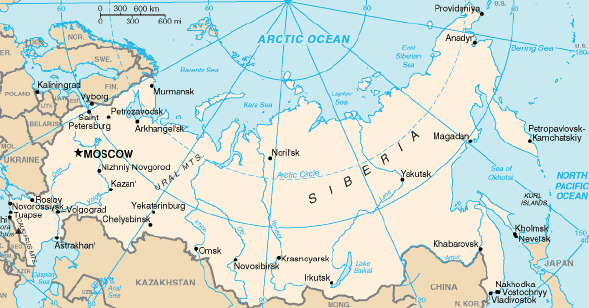| Russia Table of Contents
CURVING AROUND THE NORTH POLE in a huge arc, Russia (the Russian Federation) spans almost half the globe from east to west and about 4,000 kilometers from north to south. Divided into eleven time zones, Russia is by far the world's largest country. It occupies much of Eastern Europe and northern Asia. The country's terrain is diverse, with extensive stands of forest, numerous mountain ranges, and vast plains. On and below the surface of the land are extensive reserves of natural resources that provide the nation with enormous potential wealth. Russia ranks sixth in the world in population, trailing China, India, the United States, Indonesia, and Brazil. The population is as varied as the terrain. Slavs (Russians, Ukrainians, and Belarusians) are the most numerous of the more than 100 European and Asiatic nationalities.
The Ural Mountains, which extend more than 2,200 kilometers from north to south, form the boundary separating the unequal European and Asian sectors of Russia. The continental divide continues another 1,375 kilometers from the southern end of the Ural Mountains through the Caspian Sea and along the Caucasus Mountains. Asian Russia is about as large as China and India combined, occupying roughly three-quarters of the nation's territory. But it is the European western quarter that is home to more than 75 percent of Russia's inhabitants. This acutely uneven distribution of human and natural resources is a striking feature of Russian geography and population. Despite government attempts to settle people in sparsely populated Asian areas abundant in resources, this imbalance persists. Meanwhile, depletion of water and fuel resources in the European part outpaces exploitation of resource-rich Siberia, the famously forbidding land stretching from the Urals to the Pacific Ocean. From 1970 to 1989, the campaign to settle and exploit western Siberia's plentiful fuel and energy supplies was expensive and only partially successful. Since glasnost, revelations of extreme environmental degradation have tarnished the image of the Siberian development program. The Soviet and Russian environmental record has been generally dismal. Seven decades of Soviet rule left irradiated landscapes and marine ecosystems, a desiccated inland sea, befouled rivers, and toxic urban air as reminders of the consequences of seeking industrialization at any price. Russia and the other Soviet republics responded to the pressures of the long and costly Cold War by developing a defense-oriented, production-obsessed economy amid ecological devastation. Without a genuine environmental movement until its final years, the Soviet Union left in its wake an environmental catastrophe that will take decades and perhaps trillions of dollars to repair even partially. During the Soviet period, natural and geopolitical phenomena shaped the characteristics of Russia's population. In that period, wars, epidemics, famines, and state-sanctioned mass killings claimed millions of victims. Before the 1950s, each decade brought to the population of the former Russian Republic some form of cataclysmic demographic event. Demographers have calculated that a total of 33.6 million people died from a brutal collectivization process and the famine that ensued in the 1920s and 1930s, the Great Terror of Joseph V. Stalin (in office 1927-53) in the 1930s, and World War II. Although those events ended more than fifty years ago, such disasters have had significant long-term effects. In age-groups above forty-five, women greatly outnumber men. Russia's topography includes the world's deepest lake and Europe's highest mountain and longest river. The topography and climate, however, resemble those of the northernmost portion of the North American continent. The northern forests and the plains bordering them to the south find their closest counterparts in the Yukon Territory and in the wide swath of land extending across most of Canada. The terrain, climate, and settlement patterns of Siberia are similar to those of Alaska and Canada.
Global Position and Boundaries 
Custom Search
Source: U.S. Library of Congress |
